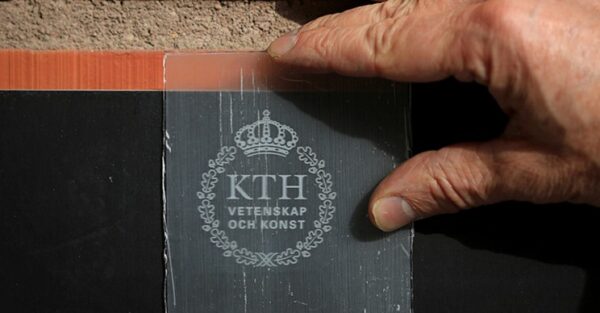The researchers of Kth Royal Institute of Technology in Sweden announced an improvement in their transparent wood introduced five years ago. The new research has made their 100% renewable and translucent composite material. The researchers infused their transparent wood with a clear bio-plastic derived from citrus.
The key to make wood in a transparent composite material is outnowering its lignin which is the light absorbing component in the wood. However, the pores left to empty after stripping the lignin must be filled with something to restore the natural force of the material and allow the light to penetrate. Previous versions of the material use fossil polymers.
The researchers have completed tests with an environmentally friendly alternative called Limonene Acrylate, a monomer made from Limonene. The material is made from renewable citrus fruits, such as recycled peel waste from the orange juice industry. The composite provides an optical transmission of 90% to a thickness of 1.2 millimeters and a remarkably low wheelbarrow of 30%.
The new material is intended for structural use and presents heavy performance with a resistance of 174 MPa and elasticity of 17 GPa while being sustainable. Researchers have sought a way to replace fossil-based polymers and replacement has been considered a major challenge for making sustainable transparent wood.
KTH advances could allow transparent wood to be used in a range of applications, including intelligent windows, wood for thermal storage, wood that has an integrated lighting function and possibly a wooden laser. Currently, researchers work with the group of photonics in KTH to further explore the possibilities of nanotechnology. The improved material is carried out without solvent and only bio-derivative chemicals are used












![Have you been encountering the [pii_email_2c5d108980d117c8ca52] error while trying to send or receive emails using your Outlook account, you’re not alone. It’s a standard Outlook error that sometimes gets triggered thanks to network connectivity issues. However, several other factors also can cause you to run into the said error. The good news is that you simply can troubleshoot this error by yourself. during this guide, we are getting to mention various factors that cause the PII error and what methods you'll utilize to repair it. So, with none further ado, let’s start . What Causes the [pii_email_2c5d108980d117c8ca52] Error in MS Outlook In general, the error occurs when MS Outlook fails to determine a secure reference to the e-mail server. But, as we mentioned earlier, there are many other reasons which will trigger this error also . a number of these reasons include: Your device isn't connected to a lively Internet connection Your Outlook profile has been damaged thanks to external factors There are incorrect antivirus configurations on your PC FIles on your POP3 server are damaged How to Fix [pii_email_2c5d108980d117c8ca52] Error So, now that you simply know what triggers the [pii_email_2c5d108980d117c8ca52] error in Outlook, let’s take a glance at the solutions that’ll assist you fix it. Also examine the way to fix outlook [pii_email_316cb5e2e59f1ce78052] error Check Your Internet Connection Since a poor network connection is that the primary explanation for the error, start by checking your Internet connection. confirm that your device has active Internet connectivity. you'll try accessing other online services to ascertain if the web is functioning or not. Change Antivirus Configurations If you've got recently installed an Antivirus program on your PC, it'd be configured to automatically scan emails. If that’s the case, the Antivirus will restrict the Outlook app from functioning properly. So, confirm to vary the Antivirus Configurations by disabling the “Email Scanning” feature. Reinstall/Update Outlook Reinstalling or updating Outlook to the newest version is yet one more effective thanks to fix the [pii_email_2c5d108980d117c8ca52] error. When you’ll reinstall the app, all the damaged temporary files are going to be deleted and therefore the root of the matter are going to be eliminated also . Clear Unnecessary Emails from Outlook Folder If your primary inbox has too many unnecessary emails, they’ll cause bandwidth issues. this is often the rationale it’s always advised to clear the unnecessary emails from your Outlook folders. While you’re at it, confirm to clear the Trash also . this may help your Outlook app to deliver optimal performance. Conclusion So, if you’ve been encountering the [pii_email_2c5d108980d117c8ca52] error for a short time now, the above-mentioned will assist you fix the matter . Follow these tricks and access your Outlook account with none hassle.](https://tomtomworks.com/wp-content/uploads/2021/09/How-to-fix-outlook-pii_email_2c5d108980d117c8ca52-er-200x200.webp)

![How To Fix [pii_email_71e6bcfa8a2bee2aa151] Erro](https://tomtomworks.com/wp-content/uploads/2021/09/How-To-Fix-pii_email_71e6bcfa8a2bee2aa151-Erro-200x200.jpg)




